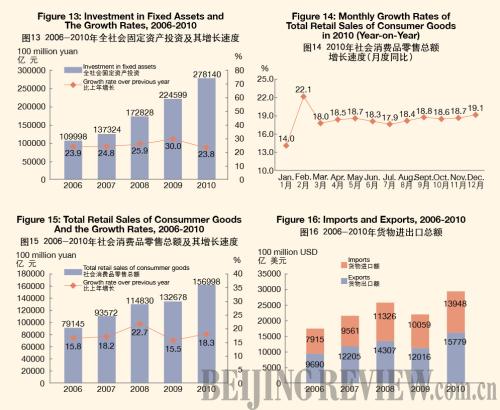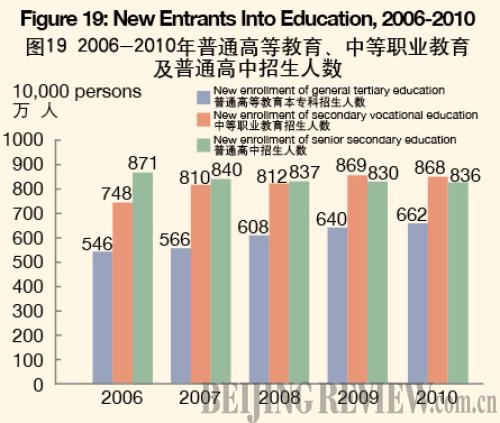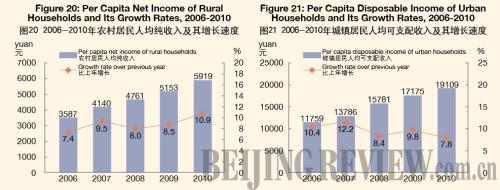|
The total stock of water resources in 2010 was 2,847.0 billion cubic meters, a year-on-year increase of 17.7 percent. The annual average precipitation was 682 millimeters, up by 15.4 percent. At the end of 2010, 422 large reservoirs in China stored 209.1 billion cubic meters of water, or 28.4 billion cubic meters more than that at the end of 2009. Total water consumption went up by 0.4 percent to reach 599.0 billion cubic meters, of which water consumption for living purposes rose by 2.9 percent; for industrial use grew by 1.4 percent; for agricultural use dropped by 0.6 percent; and for ecological water supplement increased by 6.8 percent. Water consumption for every 10,000 yuan worth of GDP produced[21] was 190.6 cubic meters, a decline of 9.1 percent. Water consumption for every 10,000 yuan worth of industrial value added was 105.0 cubic meters, down by 9.6 percent.
In 2010, a total of 5.92 million hectares of forest were planted, of which 3.89 million were afforested by manpower. Some 3.46 million hectares were afforested through key afforestation projects, accounting for 58.4 percent of the total planted area of the year. By the end of 2010, there were 2,588 natural reserves including 319 national ones. A total of 42,000 square kilometers of eroded land were put under comprehensive treatment programs, and 25,000 square kilometers of land were closed for nurture and protection in areas suffering water and soil erosion. By the end of 2010, the total forest areas with set ownership were 162.04 million hectares, of this total, 133.96 million hectares obtained the forest ownership certifications.
The average temperature in 2010 was 9.5℃. Typhoon hit China seven times in 2010.

Preliminary estimation indicated that the total energy consumption in 2010 amounted to 3.25 billion tons of standard coal equivalent, up 5.9 percent over 2009. The consumption of coal grew by 5.3 percent; crude oil, up 12.9 percent; natural gas, up 18.2 percent; and electric power, up 13.1 percent. The national energy consumption per 10,000 yuan worth of GDP went down by 4.01 percent. The consumption of major kinds of raw materials included 770 million tons of rolled steel, up 12.4 percent; 7.92 million tons of copper, up by 5.1 percent; 15.26 million tons of electrolytic aluminum, up by 6.0 percent; 14.19 million tons of ethylene, up by 32.3 percent; and 1.86 billion tons of cement, up by 14.5 percent.
Monitoring of water quality on 408 sections of the seven major water systems in China showed that 59.6 percent of the sections met the national quality standard from Grade I to Grade III for surface water, up by 2.2 percentage points over the previous year, and 16.4 percent were worse than Grade V, down by 2.0 percentage points compared with that in the previous year. Generally, the water quality in the seven major water systems continued to improve with some river basins still having serious pollution.
Monitoring of oceanic water quality at 298 offshore monitoring stations indicated that oceanic water met the national quality standard Grade I and II in 62.8 percent of the stations, down by 10.1 percentage points from the previous year; water quality at 14.1 percent of the stations met Grade III standard, up by 8.1 percentage points, and water of Grade IV or inferior quality was found at 23.2 percent of the stations, up by 2.1 percentage points.
In the 330 cities covered by air quality monitoring program, 273 cities reached or topped air quality standard Grade II, accounting for 82.7 percent of all cities under the program; 53 cities attained Grade III, accounting for 16.1 percent; and air quality in four cities was inferior to Grade III, accounting for 1.2 percent. Of the 331 cities subject to noise monitoring program, 6.3 percent enjoyed fairly good environment; 67.4 percent had good environment; 25.4 percent had light noise pollution; and 0.9 percent experienced medium noise pollution in downtown areas.

At the end of 2010, the daily treatment capacity of city sewage reached 102.62 million cubic meters, up 13.4 percent over that in 2009. City sewage treatment rate was 76.9 percent, up 1.6 percentage points. The floor space with central heating systems amounted to 3.91 billion square meters, up 3.0 percent. Greenery coverage reached 34.5 percent of the urban area, up 0.3 percentage point.
In 2010, natural disasters caused 534.0 billion yuan worth of direct economic loss, an increase of 1.1 folds over that in previous year. Natural disasters hit 37.43 million hectares of crops, down by 20.7 percent, of which 4.86 million hectares of crops were demolished, down by 1.1 percent. Flood and waterlog, landslide and debris flow caused a direct economic loss of 350.5 billion yuan, an increase of 4.4 folds and left a death toll of 3,101. Drought caused a direct economic loss of 75.7 billion yuan, down by 31.2 percent. Disasters from low temperature, frost and snow made a total direct economic loss of 31.8 billion yuan with a death toll of 51. Oceanic disasters caused a direct economic loss of 14.94 billion yuan, up by 49.1 percent. The occurrence of red tides hit an accumulative area of 10,892 square kilometers, down by 22.8 percent. The country recorded 17 earthquakes with 5-magnitude and over, 10 of which caused disasters, causing a direct economic loss of 23.57 billion yuan and leaving a death toll of 2,705. The year 2010 witnessed 7,723 forest fires, down by 12.8 percent.

The death toll due to work accidents amounted to 79,552 people, a year-on-year decrease of 4.4 percent. The death toll from work accidents every 100 million yuan worth of GDP was 0.201 people, a decline of 19.0 percent. Work accidents in industrial, mining and commercial enterprises caused 2.13 deaths out of every 100,000 employees, down 11.3 percent. The road traffic death toll per 10,000 vehicles was 3.2 persons, down 11.1 percent. The death toll for producing 1 million tons of coal in coalmines was 0.749 persons, down 16.0 percent. n
____________
Notes:
1. All figures in this Communiqué are preliminary statistics. Statistics in this Communiqué do not include Hong Kong SAR, Macao SAR and Taiwan Province. Due to the rounding-off reasons, the subentries may not add up to the aggregate totals.
2. Gross domestic product (GDP) and value added as quoted in this Communiqué are calculated at current prices, whereas their growth rates are at constant prices.
3. The number of migrant workers includes those who obtain employment outside their villages and towns for more than six months in the year and those who do non-agricultural work in their villages and towns for more than six months in the year.
4. Six highly energy-consuming industries are: manufacture of raw chemical materials and chemical products, manufacture of non-metallic mineral products, smelting and pressing of ferrous metals, smelting and pressing of non-ferrous metals, oil processing, coking and nuclear fuel processing, and production and supply of electricity and heat.
5. Output and consumption of rolled steel include duplicated counting of rolled steel as intermediate inputs used for producing other types of rolled steel.
6. The national total of fixed assets investment is larger than the aggregate sum by adding up the subtotals of fixed assets investment in the eastern areas, central areas, western areas and northeast areas due to the fact that some of the trans-regional investments are not covered by regional figures. The eastern areas include 10 provinces and municipalities: Beijing, Shanghai, Tianjin, Hebei, Jiangsu, Zhejiang, Fujian, Shandong, Guangdong and Hainan; central areas cover six provinces: Shanxi, Anhui, Jiangxi, Henan, Hubei and Hunan; western areas include 12 provinces, autonomous regions and municipality: Inner Mongolia, Guangxi, Chongqing, Sichuan, Guizhou, Yunnan, Tibet, Shaanxi, Gansu, Qinghai, Ningxia and Xinjiang; northeastern areas include three provinces: Liaoning, Jilin and Heilongjiang.
7. The investment in real estate includes the investment made in real estate development, construction of buildings for own use, property management, intermediary services and other real estate development.
8. From 2010, new grouping method is adopted for the statistics on the total retail sales of consumer goods: grouping according to operation location changes from city, county and below county level to urban and rural areas; grouping according to industries is cancelled and new grouping according to retail sales of commodities and earnings of catering is added.
9. The turnover of post and telecommunication services is calculated at constant prices of 2,000.
10. The capacity of mobile phone switchboard refers to the number of maximum concurrent users calculated by the mobile phone switchboard according to certain calling model and switchboard processing capacity.
11. 3G refers to the third generation cellular mobile communication system (third-generation, abbreviated as 3G); 3G mobile phone users refer to those who with use of information in the billing system and use 3G network resources at the end of the reporting period.
12. The original premium income received by the insurance companies refers to the premium income from original insurance contracts confirmed by the insurance companies.
13. The coverage of enterprises finishing products certification is adjusted: the original coverage only includes compulsory product certification, but in 2010, non-compulsory certification is also included.
14. Special movies refer to those using different display modes in terms of projection techniques, equipment and program as compared with the ordinary cinemas, such as IMAX movies, 3D movies, 4D movies, multidimensional movies and fulldome movies.
15. The coverage of health institutions is adjusted: data of year 2010 includes clinics in villages.
16. The total number of population at the end of 2010 is the preliminary estimation. In April 2011, the communiqué of the sixth national population census is planned to be released, data on number and structure of population in that communiqué shall be taken as final.
17. The number of people covered in urban basic health insurance programs for urban staff and workers includes staff and workers and retirees insured. The urban basic health insurance programs for urban residents refer to urban non-employed residents who are not covered by the urban basic health insurance programs for staff and workers.
18. Five-guarantee relief in rural areas refers to villagers who are aged, disabled or under the age of 16 and have no ability to work, no source of income and no statutory obligors to provide for them, bring them up or support them, or whose statutory obligors have no ability to provide for them, bring them up or support them, shall enjoy life-care and physical care in terms of food, clothing, housing, medical care and funeral expenses.
19. Total supply of land for construction use refers to the supply of state-owned land for construction use with the land-used right sold, allocated or leased to units or individuals by the municipal or county governments according to annual land supply plan and in line with relevant laws in the reporting period.
20. According to "Technical Standards for Monitoring Land Prices in Cities," land prices refer to land price level which is based on prices in selected monitoring cities, incorporating transaction prices on comprehensive land market and real estate market which reflects the overall land price level in cities. Comprehensive land prices refer to the average price level of land in the same city or region for different purpose of use.
21. The consumption of water and energy for producing 10,000 yuan worth of GDP is calculated at 2005 constant prices.
Source: www.stats.gov.cn |
